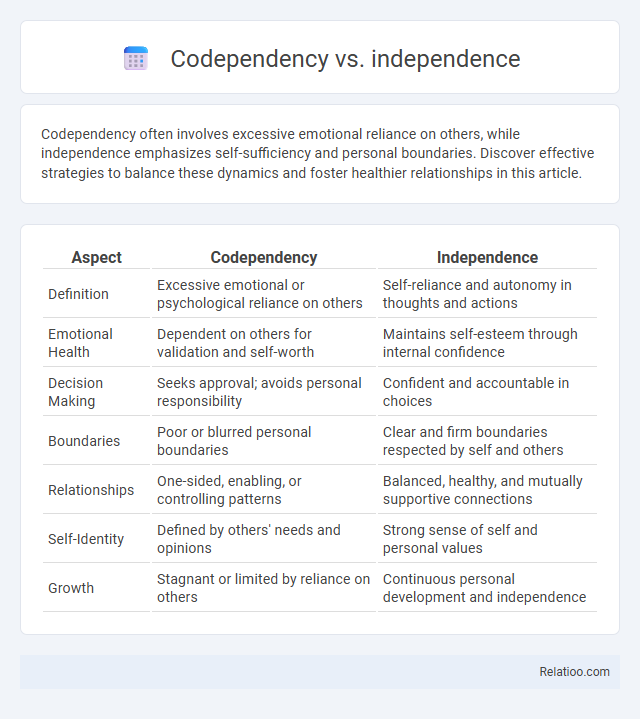Codependency often involves excessive emotional reliance on others, while independence emphasizes self-sufficiency and personal boundaries. Discover effective strategies to balance these dynamics and foster healthier relationships in this article.
Table of Comparison
| Aspect | Codependency | Independence |
|---|---|---|
| Definition | Excessive emotional or psychological reliance on others | Self-reliance and autonomy in thoughts and actions |
| Emotional Health | Dependent on others for validation and self-worth | Maintains self-esteem through internal confidence |
| Decision Making | Seeks approval; avoids personal responsibility | Confident and accountable in choices |
| Boundaries | Poor or blurred personal boundaries | Clear and firm boundaries respected by self and others |
| Relationships | One-sided, enabling, or controlling patterns | Balanced, healthy, and mutually supportive connections |
| Self-Identity | Defined by others' needs and opinions | Strong sense of self and personal values |
| Growth | Stagnant or limited by reliance on others | Continuous personal development and independence |
Understanding Codependency: Key Characteristics
Codependency is characterized by excessive emotional reliance on others, often leading to a loss of personal boundaries and self-identity. Individuals experiencing codependency frequently prioritize others' needs over their own, resulting in impaired independence and difficulty making autonomous decisions. Emotional distance acts as a contrasting dynamic, where detachment serves as a defense mechanism to avoid vulnerability often found absent in codependent relationships.
Defining Independence: What It Really Means
Independence means having the ability to think, decide, and act on your own while maintaining healthy relationships without losing your sense of self. It involves emotional self-sufficiency, where your well-being doesn't rely heavily on others' approval or support. Your emotional boundaries remain clear, ensuring balanced connections without falling into codependency or emotional distance.
The Psychological Roots of Codependency
Codependency often stems from early childhood experiences characterized by neglect, inconsistent caregiving, or trauma, leading to a deep-seated need for external validation and approval. This psychological root fosters an excessive emotional reliance on others, which contrasts sharply with independence, where individuals maintain healthy boundaries and self-sufficiency. Emotional distance can develop as a defense mechanism in codependent relationships, creating a paradoxical cycle of seeking closeness while simultaneously fearing intimacy.
Building Healthy Boundaries in Relationships
Building healthy boundaries in relationships requires recognizing codependency patterns, where excessive reliance on others undermines personal autonomy, versus fostering independence, which promotes self-reliance and emotional resilience. Emotional distance becomes problematic when it leads to disconnection, making it essential to balance closeness and space to maintain mutual respect and trust. Clear communication and self-awareness help establish boundaries that protect individual identity while nurturing healthy interdependence.
Emotional Impact: Codependency vs Independence
Codependency often results in emotional enmeshment, where individuals rely heavily on others for validation, leading to heightened vulnerability and diminished self-esteem. Independence fosters emotional resilience and self-efficacy, enabling individuals to regulate their emotions and maintain healthy boundaries without excessive reliance on external affirmation. Emotional distance, while sometimes necessary for self-protection, can create feelings of isolation and hinder emotional intimacy, contrasting sharply with the balanced emotional connection encouraged by healthy independence.
Signs You May Be Codependent or Independent
Signs you may be codependent include excessive people-pleasing, difficulty setting boundaries, and relying heavily on others for approval and self-worth. Indicators of independence are the ability to make decisions confidently, maintaining healthy boundaries, and a strong sense of self without needing external validation. Emotional distance emerges when someone consistently avoids deeper connections, suppresses feelings, and prioritizes self-protection over intimacy, often resulting in detachment and isolation.
The Role of Self-Esteem in Relationship Dynamics
Self-esteem critically influences relationship dynamics by shaping individuals' tendencies toward codependency, independence, or emotional distance. Low self-esteem often fosters codependency, causing a person to rely excessively on others for validation and support, while high self-esteem promotes independence, enabling healthier boundaries and self-sufficiency. Emotional distance can arise from either high or low self-esteem when individuals protect themselves from vulnerability, highlighting self-esteem's central role in balancing intimacy and autonomy within relationships.
Transforming Codependency into Healthy Independence
Transforming codependency into healthy independence involves recognizing your own emotional needs while setting clear boundaries to foster self-reliance and personal growth. Developing emotional resilience allows you to maintain close relationships without losing your sense of self or becoming overly reliant on others for validation. Embracing this balance reduces emotional distance by encouraging open communication and authentic connections built on mutual respect.
Codependent and Independent Relationships: Pros and Cons
Codependent relationships often involve excessive emotional reliance and a loss of personal boundaries, leading to challenges in self-identity and increased stress. Independent relationships promote autonomy and self-sufficiency, fostering personal growth but sometimes causing emotional distance or lack of intimacy. Balancing connection and independence is crucial for healthy relationships, as overly codependent or detached dynamics can hinder emotional fulfillment and mutual support.
Practical Steps to Cultivate Independence
Cultivating independence involves setting clear personal boundaries and prioritizing self-care routines that reinforce your autonomy. Engaging in activities that boost self-confidence and decision-making abilities strengthens your emotional resilience and reduces reliance on others. Practical steps include journaling your goals, seeking support when necessary without overdependence, and practicing assertiveness to maintain a healthy balance between connection and independence.

Infographic: Codependency vs independence
 relatioo.com
relatioo.com